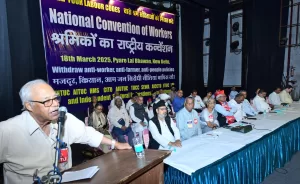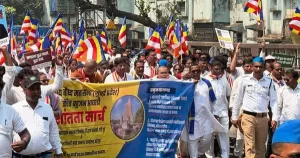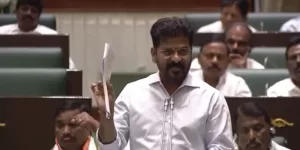In 1977-’79, when I began my research about the Adivasi groups in the Dahanu and Talasari tehsils of what is now Palghar district in Maharashtra, I witnessed extreme poverty, sexual oppression, debt bondage, uneconomic wages, physical violence among them. However, their long narrations about the dark past and the miserable present, which sometimes lasted for hours, was punctuated by the vivid and inspired memory of Godavari Parulekar, who taught them to “fight well”, and free themselves from oppressive practices of decades.
Three decades after the famous Warli revolt that she led from 1945 to 1947, Godutai, as she was affectionately known, was still a household name. She was often mentioned with deep gratitude, respect and love as the leader who liberated the region’s Adivasis from the hated practices of veth begar (debt bondage and unpaid labour) and lagnagadi (“marriage servant”, whereby a small amount borrowed by an Adivasi for marriage expenses and enslaved him to the landlord-employer for the rest of his life, sometimes for generations).
On August 14, Parulekar’s 114th birth anniversary was celebrated by several organisations in the area. It is an opportune moment to recall the role that the educated, upper-caste, upper-class young woman from Mumbai played in the region.
Intense exploitation
Parulekar began to work in Thane district in 1944 and was so appalled by the inhuman condition of the Adivasis that she resolved to organise them under the banner of the All India Kisan Sabha, to end the economic exploitation, sexual oppression and bondage by the landlord-moneylender-trader class that the Adivasis referred to as seth-saukar.
By the 1940s, most of the region’s Adivasis, who had been small cultivators and food gatherers at a low level of subsistence but independent, had been reduced to the position of tenants and agricultural labourers. They were bonded to the seth-saukar in one way or the other. This was the result of the commercialisation of agriculture and the implementation of forest laws by the British government after 1818.
The restriction of rights to the forest produce and the extraction of forced labour for little or no wages created the conditions for them to be completely dependent on the seth-saukar for survival. Physical violence, humiliation and fear were the weapons used to silence the Adivasis.
Many Adivasis pledged their labour to the seth in return for a small loan of either grain or cash. The meagre amount paid to the lagnagadis and the dishonesty of the landlords made it impossible, in most cases, for the debtors to repay their loans and free themselves from bondage. The lagnagadi’s wife and children naturally became the slaves of the seth.
In her book, Revolt of the Warlis, Godavari Parulekar testified that Advivasi women were the first to respond to the call for freedom from lagnagadi. They led processions, they would come out singing to conferences, they went from house to house to ask the gadis (bondage labour) to come out. Warli women displayed great courage in withstanding physical torture, molestation and threat of rape by the police and landlords’ musclemen.
In mid-1980s, Parulekar’s memory was very fresh in the minds of the Adivasis. In fact, a few men and women who had participated in the revolt, were still living and eagerly shared their experiences with me. Their spirited testimonies brought alive the nature and quality of their participation in their struggle.
Devlu, who was approximately 70 years old, narrated her story with great enthusiasm and pride, repeating throughout her narration, “We also fought well.”
More articulate and vivacious than her husband, she occasionally turned to him to confirm some facts. She enacted the way the musclemen and mukaddams used to drive the Adivasis to work, kicking and abusing them. Devlu then described the way in which the Adivasis chased the police and the awaris during the struggle
She was transformed as she relived the events of the past. The moist eyes in her old wrinkled face began to shine and her thin arms and legs moved with tremendous power as she conveyed to us the transformative power of the struggle. She became the symbol of that collective strength, for the moment.
Decades of humiliation
She described decades of oppression and humiliation in following words:
“Long ago the saukars and the awaris harassed us, Adivasis. The saukars demanded veth from us. They demanded paddy, vegetables and chicken, and we had to give whatever they asked for. Men and women were made to work the whole day for just a little rice. The awaris would come around, beat us and take us to work. Saukars needed women every night and good-looking women were called by them. The awaris were bhaiyyas and few Warlis. They worked as mukaddams for the saukar and they beat us. They also harassed women.
“The husband could not do anything. He kept quiet. If he said anything, he was beaten. There was no peace for us, no peace for our animals. There was a lot of oppression at that time. It was very bad.
“Then Godutai came. She had a meeting in Titwala. Some men and women went to Titwalla. We told Godutai about the oppression by saukars. We told her about veth. We told her, ‘Do something.’ There was a strike. All stopped work. No veth, no work for the saukar. Women stopped work. There was a meeting at Zari. Many women went to the meeting with small children. Women did not give speeches but women spoke to Godutai about the oppression by saukar and awaris.”
Another woman spoke proudly about how Adivasi women confronted the police:
“Women went along with Godutai. They spoke at meetings about their oppression. Women spoke at meetings and told other women to join the struggle. Women were not afraid. When the police came looking for men, women would hide them in the house and go out and tell the police, ‘Go away, no one is at home.’ The police would threaten the women and ask them where the men were hiding. Women used to reply, ‘Take me away but I will not tell you where the men are.’
“We were taught by Godutai not to give any information to the police. Women faced the police fearlessly. We showed the police lathis and told them, ‘You have your guns, these are our guns.’ You used to oppress us, use force on us but now we are stronger than you. We were ready to fight with our lathis.
“We had guns made out of wood. These looked like real guns from far. We used to frighten the police with these guns. The police were afraid. Sometimes many women used to chase the police out of the pada. When men were hiding in the forest, women used to take food and water for them in small baskets covered with dry cowdung so that no one could see what we were carrying.
“We were not afraid. Godutai had secret meetings in the forest and many women used to attend these meetings. All the women joined the struggle.”
By 2005, it became clear to me that the inspiration of the Warli revolt, the magic of Parulekar’s fearless and determined presence, and of their own courageous participation nearly five decades ago was beginning to fade into a distant image.
This is not to suggest that the Adivasis are not politically active. In fact, the Kisan Sabha and political organisations like Kashtakari Sanghatana and several others continue to organise Adivasis around issues of land, forest, wages, with varying degrees of success. The restoration of forest rights to Adivasis by Forest Act of 2006 has been a major achievement of these organisations in recent times.
However, the life stories of Adivasi men and women, which I recorded during this time, showed that mainly those in their 60s recalled Parulekar’s charisma, the scale of the struggle and its successful outcome with pride and appreciation.
Radkibai, a feisty woman, a member of Kashtakari Sanghatana, recalled the end of the pernicious practices of the time, although she was quick to add that the forest issues were not taken up by the struggle. Others remembered the huge meetings, and the speeches Parulekar gave to dispel the fear and despondence that had gripped the Adivasis, and rendered them voiceless.
But sadly, the younger men and women in their 20s, 30s and 40s showed little awareness or interest in their history.
In this context two points emerge as significant.
One, in general, till some decades earlier, the historiography of popular struggles on the one hand, subsumed women under the category of “man”, thereby ensuring their invisibility, and created the myth of women’s passivity.
On the other, it gave rise to the belief that men alone were capable of militant action, of leadership, of changing the course of events, in short, of making history.
Deprived of initiative and agency, women actors were portrayed, at best, as followers in historical writings. Godavari Parulekar’s leadership as well as the brave resistance by Adivasi women add a new perspective to our views on popular struggle.
In India, women emerged as an important force in support of the national movement under the leadership of Gandhi. Women’s organisations sprang up all over the country with a view to further women’s cause as well as that of the country’s independence. But equally impressive were the struggles of Adivasi women and men against exploitation and oppression of the colonial government as well as that of the landlord-trader-forest contractor, diku, the outsider, which occurred in many parts of the country.
Two, while it is expected that memories of the events, however important, begin to fade over time, what is of concern is the fact that little effort is made to document, to revive and popularise the history of marginalised communities. Formal education imparted to Adivasi children in government-run ashram shalas, for example, has little place or respect for their own past.
At the same time other factors like dislocation, migration, growing domination by majority cultures and religions, and gradual disintegration of the communities, destroy the knowledge of their past. As a result forms of cultural articulation and transmission that would evoke pride, confidence, and understanding of their community identity, the good and bad, are also lost.
Collective memory, which is fast being eroded, ought to be preserved in formal education, political action and also in everyday life practices of the community. This would remind the members of their collective weaknesses and strengths, successes and failures and to draw lessons that would help them improve their present and future.
(Indra Munshi is the executive editor, Indian Journal of Secularism at the Centre for Study of Society and Secularism, Mumbai. Courtesy: Scroll.in.)




